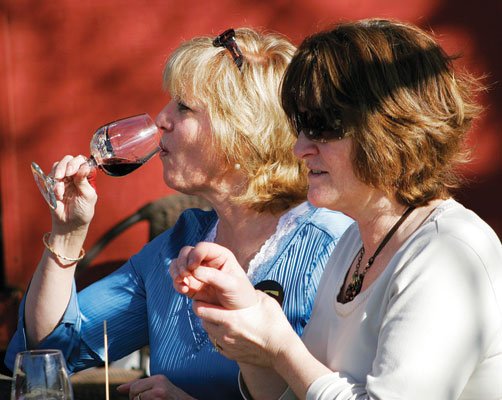As recently displayed by the multitude of awards bestowed upon
local wineries at the largest competition of American wines in the
world, the wineries of the Santa Clara Valley are holding their own
among industry giants from the Napa Valley and Sonoma wine
country.
As recently displayed by the multitude of awards bestowed upon local wineries at the largest competition of American wines in the world, the wineries of the Santa Clara Valley are holding their own among industry giants from the Napa Valley and Sonoma wine country.
Several local vintners sent their best picks to the San Francisco Chronicle Wine Competition to compete with more than 4,000 wines submitted by 1,500 wineries across the country. A panel of 60 professional wine judges sipped and savored the intoxicating contenders. Among the winners were a handful of local favorites sprinkled about the agriculture-rich region.
That the area surrounding Gilroy, Hollister and Morgan Hill is California’s oldest continuous wine producing region is often forgotten, overshadowed by the looming presence of big name appellations in the north. While Napa and Sonoma boast quantity and a world famous moniker, the Santa Clara Valley has time on its side.
With 70-year-old vines on his property, Gino Fortino, co-owner of Fortino Winery which churns out between 12,000 and 15,000 cases per year, sees wineries come and go but has noticed more and more people venturing south to seek out new varietals.
“They were just as small as us in the ’70s,” he said of wine country up north. “Napa just has a better marketing machine. There’s no difference in growing region. With cooler nights and nice, warm days in the summer, ours is one of the best in California.”
While many wineries, such as Fortino’s, use their tasting rooms as a marketing tool, Six Strings Winery in San Juan Bautista is singing a different tune. Sans tasting room, their main marketing pull is their innovative spin on wine pairings. Inspired by music, they match their wines with various melodies, rather than foods.
“Certain kinds of music go with certain types of wine,” said co-owner, Gary Cornick.
His favorite: his Santa Lucia Highlands Pinot Noir. Musical pairing: electric blues.
“It just came out perfectly,” he said of the selection. “Wines are whatever you like. It’s very subjective. Very similar to music.”
A vineyard that produces about 1,000 cases of wine per year, Cornick is shooting for 5,000 and is leery of becoming to large and unwieldy.
“The way we do it, with small production and hand crafted wines … they can’t do that,” he said of larger wineries.
Other vintners agreed that there seems to be a magical production number but few could put a finger on exactly what that number was.
“Bigger’s not always better,” said Larry Spivak, the tasting room manager at Emilio Guglielmo Winery in Morgan Hill. “It gets too large and you can’t really take care of everything. You stay small and you have more control.”
Compared to Six Strings, Guglielmo’s production is huge, at about 20,000 cases a year, it is a “very large small winery,” Spivak said. And Guglielmo isn’t looking to double it’s production any time soon.
“We’re in the business of making wine,” Spivak said, “not manufacturing it.”
Tradition is a recurring theme in the Santa Clara Valley, where many of the wineries are family owned. Carlo Fortino’s parents own Hecker Pass Winery and cousin, Gino, owns Fortino Winery. Although they are two independent businesses, both have decades old vines that are watered by Mother Nature, rather than manmade irrigation systems.
“Napa is an interesting area, but very commercialized,” Carlo Fortino said. The idea of people arriving by the busload and having to elbow their way through four rows of wine tasters to get to the bar is not appealing to him.
“I don’t think it’ll get like that here,” he said. “In a good way!”
California is home to 2,687 licensed wineries, according to the Wine Institute, and contributes more than 90 percent of all U.S. wine production. California is the fourth leading wine-producing region in the world, behind Italy, France and Spain. California’s wine sales topped 449 million gallons – 188.9 million nine-liter cases – in 2006, with a retail value of $17.8 billion, according to wine industry consultant Jon Fredrikson. In Sonoma County alone, about 128 million cases of wine are produced from Sonoma grown and crushed grapes per year, said Sonoma County Vintners Director of Communications Phil Bilodeau.
The Santa Clara Valley offers variety too. Large and small, the area has many family owned businesses. But not all of them pride themselves on decades of tradition. Sarah’s Vineyard is a “modern winery” said sales manager, Tim O’Kelley. “We like to stay on the cutting edge … and won’t do something for the sake of tradition as a gimmick.”
At about 4,000 cases a year, Sarah’s will probably stay that way, O’Kelley said. With a focus on quality, rather than quantity, O’Kelley wants to keep the numbers in check to have more control of the product.
Many local wineries, including Sarah’s, have united as a way to promote their region. The Wineries of Santa Clara Valley is a collection of local wine makers that receives regional marketing funds from the Gilroy Visitors Bureau and the Morgan Hill Chamber of Commerce to promote the wines of the valley.
“People aren’t aware of the great wines we’re producing,” said Jane Howard, executive director of the Gilroy Visitors Bureau. “Because wineries had not been marketing themselves as an organization, they got lost in the shuffle. But now they’re gaining more and more notoriety.”
President of the Wineries of Santa Clara Valley and owner of Pedrizzetti Winery in Morgan Hill, Mike Sampognaro said the organization is geared toward “trying to educate the local community about the fact that we exist.” Sampognaro sees equivalence between the famous wineries in the north and the lesser known wineries of the Santa Clara Valley.
“We have an assortment of wineries that give them as good a product as in Napa County,” he said. “They have a tremendous budget for advertising and put on a big show but we’re more customer oriented.”
The love for wines and customer relations is evident at Solis Winery, where brothers Vic and Michael Vanni often pick up the phone themselves after only a couple rings. At Solis, they savor the cycle of production from beginning to end. From the first green of March to the “hot and heavy” harvesting season in the fall to the winter holidays when wine lovers fill their tasting room, the Vannis enjoy each season at the vineyard. A breathtaking view of the lush Santa Cruz Mountains sets the backdrop to the rows of Chardonnay, Merlot and Sangiovese grapes planted on their property.
“We love our product,” Vic Vanni said, as all vintners do.
Santa Clara Valley winery owners also agree on something else – “As opposed to Napa, this region has super high quality wines at very affordable prices,” said Rapazzini Winery owner, Alex Larson. And fellow vintner and owner of Mann Cellars, Mike Mann, agreed. “Napa has a reputation and that’s fine. But the value and friendliness of our wineries mean so much more.”















